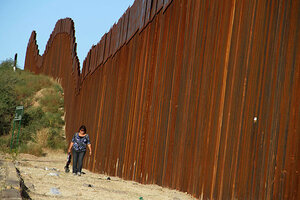Bullets vs. rocks? Border Patrol under fire for use of deadly force.
An Oct. 10 incident, in which a Border Patrol agent fired his gun in response to rock-throwing, leaving a 16-year-old dead, is drawing attention to the Border Patrol's use-of-force policy.

A woman walks past the border fence between Mexico and the US, near the site where a 16-year-old boy was shot at by a US Border Patrol agent on Oct. 10.
Alonso Castillo/REUTERS/File
NOGALES, ARIZ.
It's a scene all too familiar on this Arizona stretch of the Southwest border: One or more people, under the cover of darkness, clamber over the tall metal fence that is the international boundary in a mad rush to smuggle marijuana bundles into the United States without detection.
On Oct. 10, authorities say, a similar incident resulted in the death of 16-year-old José Antonio Elena Rodriguez, shot multiple times after a Border Patrol agent responded with gunfire to a rock attack.
Under Border Patrol policy, bullets can be a justified response to rocks, because rocks have caused serious injuries to agents in the past. But both American civil liberties groups and Mexican authorities are drawing attention to the incident, saying it raises worrying questions not only about the Border Patrol's use of force, but also its recent surge of manpower along the border.
The teen became at least the 16th person to die along the 2,000-mile border at the hands of the Border Patrol since January 2010 – and the eighth in which agents have cited rock-throwing as a reason for using deadly force, according to border watch groups.
The FBI is investigating, as are Mexican officials. At the behest of concerned members of Congress, the Office of Inspector General is already reviewing border agencies' use-of-force guidelines in connection with a different incident.
A primary concern is whether a hiring boom in recent years has hurt training.
"This massive increase of agents with very little proportional accountability and oversight, I think has led to some problems," says Vicki Gaubeca, director of the American Civil Liberties Union's Regional Center for Border Rights in Las Cruces, N.M.
The Border Patrol, which in 2003 became part of the Department of Homeland Security under Customs and Border Protection, has more than doubled its size to approximately 21,000 agents since 2004. Most, close to 18,500, guard the Southwest border, Homeland Security Secretary Janet Napolitano told a congressional committee in September.
Customs and Border Protection (CBP) representatives in Arizona, Washington, and Texas, declined to discuss the agency's use-of-force policy or any of the agent-involved fatalities.
“CBP law enforcement personnel are trained to use deadly force in circumstances that pose a threat to their lives, the lives of their fellow law enforcement partners and innocent third parties,” agency spokesman Michael Friel said in a statement.
In fiscal 2012, the agency recorded 249 rock-throwing incidents along the Southwest border, down from 769 in 2008. Although rock-throwing is the most common form of assault, agents also must contend with attacks involving vehicles and weapons, for example.
Few details are known about what transpired in Nogales on Oct. 10.
US authorities have said that agents came under attack from rock-throwers as several suspects carrying marijuana were fleeing back into Mexico. "After verbal commands from agents to cease were ignored, one agent then discharged his service firearm," according to an Oct. 11 press release by CBP.
But an attorney for José's family, Luis Parra, maintains José was on his way to a neighborhood store and was "in the wrong place at the wrong time." Mr. Parra is trying to gain access to a Border Patrol surveillance video that he says may have recorded the shooting.
Mexican officials have raised concerns about the incident, as well as the broader Border Patrol policy.
"The disproportionate use of lethal force in the exercise of immigration control functions is unacceptable under any circumstances," the Mexican Ministry of Exterior Relations said in a statement. "These kinds of acts, especially because they are recurring, have been rejected by Mexican society and all of the country's political powers."
It has pressed the US to make its investigations "exhaustive, timely and transparent." Mexican officials plan to release José's autopsy and the ballistics report before year's end, says Parra. Reports suggest José was shot several times.
Ms. Gaubeca echoes Mexico's concerns about the Border Patrol's use of force, noting that no agent has died in a rock attack.
"The reality is, it's not equal force," she says. "The damage a rock can do is not the same as the damage a bullet can do."
Oftentimes, border confrontations result in contradictory accounts from eyewitnesses and agents.
In a 2010 San Diego case that caught the attention of several members of Congress, the Border Patrol said Anastasio Hernandez Rojas, a Mexican national, had resisted arrest. An eyewitness video later showed the 42-year-old man on the ground, surrounded by border agents and pleading for his life when he was shot with a Taser stun gun. He later suffered a heart attack and died.
José's case is one of three involving Arizona agents that remain unresolved. Questions still surround two other shootings last year that killed 17-year-old Ramsés Barrón Torres, of Nogales, Mexico, and 19-year-old Carlos Lamadrid of Douglas, Ariz.

